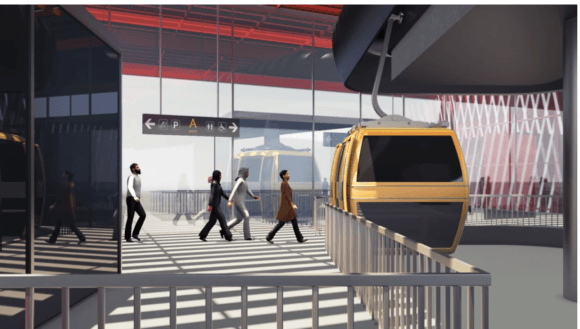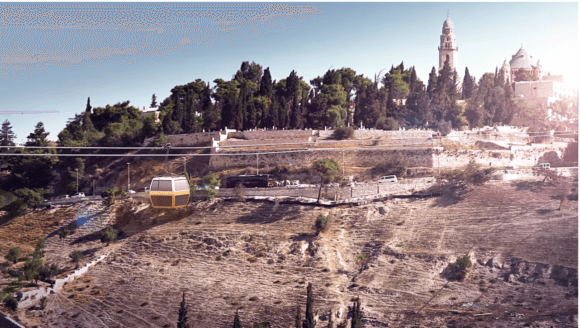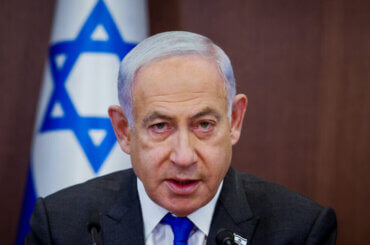UNITED NATIONS — A plan to build a cable car for tourists in Jerusalem’s Old City has largely been a local issue so far. That changed on on Thursday, when Palestinian concerns about the new transit route were raised to the international level at a United Nations debate on the fragile peace process.
Nickolay Mladenov, the UN’s Middle East envoy, cited the cable car — alongside Israeli settlement-building and the blockade of Gaza — as obstacles in a negotiation process between Israelis and Palestinians that the Trump administration aims to reinvigorate at talks in Bahrain next week.
The 1.4-kilometer cable car route, which will take tourists to within walking distance of the historic Western Wall, has stoked fears of Arab neighborhoods becoming ever-more marginalized, Mladenov told the UN Security Council.
“On 3 June, Israel’s National Infrastructure Committee rejected a series of objections against a controversial plan to construct a cable car between West Jerusalem and the Old City and submitted the plan for government approval,” Mladenov said on Thursday.
“This plan has raised concerns among Palestinian residents of East Jerusalem and Israeli non-governmental organizations that it seeks to deepen Israeli control over the area.”
The $56 million (200 million NIS) scheme is led by Israel’s Ministry of Tourism and the Jerusalem Development Authority and is expected to carry 3,000 passengers per hour on four-and-a-half-minute rides through the Old City.

Under the plan, gondolas carrying as many as 73 passengers would pass above the neighborhood of Abu Tor, the Valley of Hinnom, and end at the Kedem Center for tourists in the Silwan area.
Advocates of the plan say it will reduce the number of tourist buses that currently cram the city’s narrow streets.
Critics say the project would mar the historic landscape of the Old City and increase the Jewish presence in the Arab neighborhood of Silwan at a time that Palestinians feel their livelihoods are under increasing threat.
Worse still, detractors note the involvement of the Elad Foundation, a group that settles Jewish nationalists in some of Jerusalem’s Arab areas. The cable car terminus will be integrated into a future tourist center run by that group.
Last year, Betty Herschman of Ir Amim, an advocacy outfit that promotes equality in the city, told her concerns to the Associated Press.
“The cable car will send oblivious tourists flying over the heads of Palestinians and drop them off in the middle of occupied east Jerusalem, the eye of the storm, the …. center of the Israeli-Palestinian conflict,” said Herschman.
“This cable car is putting new facts on the ground that undermine any possibility for a peace process.”
The Silwan neighborhood is already tense, said Mladenov. Eleven people had to vacate the area on April 30, as their homes were demolished. Some 50 legal cases about other homes and structures in the area are pending in Israeli courts, he added.
After getting a green light from the infrastructure committee, the cable car plan must be submitted to the government for approval.
Mladenov said that relations between Israelis and Palestinians were worsening as the administration of United States President Donald Trump sought to reinvigorate the peace process at a two-day fundraiser for Palestinians in Bahrain.
The U.S. has billed the June 25-26 meet in the Gulf kingdom as an economic overture to its long-delayed Israeli-Palestinian peace plan, which is widely referred to as the “deal of the century” and is spearheaded by Trump’s son-in-law, Jared Kushner.
While details of the peace plan are still sketchy, Palestinians fear it will scrap the two-state solution — the long-standing international formula which envisages an independent Palestinian state in the West Bank, East Jerusalem and Gaza co-existing with Israel.
The U.S. plan has been met with broad skepticism, even from Washington’s European allies, who maintain support for an independent Palestinian state. But Trump’s plan is understood to have some support from such regional players as Saudi Arabia and the United Arab Emirates.
Mladenov said he was worried by a breakdown in international efforts.
“I remain deeply concerned by the state of our collective efforts and the weakening of the international consensus to achieve an end to the occupation and the realization of a negotiated two-state solution of the Israeli-Palestinian conflict,” Mladenov said.



Shame on any tourist that ignores Israel’s crimes, the occupation, theft of lands, and the almost daily killing of young kids, and visits the land of the occupiers. The arrogance of these zionists, who build their illegal businesses, and settlements, off the suffering, and misery, of those they wield power over, is unbelievable.
I can imagine all those evangelical end timers from across the plains of America chomping on diet candy bars, riding across the land of Jesus in their airy cable cars.
Yes, of course, cable car is the problem for peace in the middle east.
Not 700 rockets fired just 2 weeks ago from Gaza towards Israel, killing 4 Israelis.
A cable car.
Don’t believe the Palestinian lie.
@Yan121
Sigh.
Here’s a taste of ugly reality for you regarding “the problem for peace in the middle east.”
https://www.juancole.com/2019/06/deliberately-palestinian-civilians.html
“Is Israel Deliberately wounding Palestinian Civilians in Gaza?”
MIDDLE EAST MONITOR, June 19/19
By Asa Winstanley
“A new World Heath Organization report on Gaza this month made for shocking reading.
“But as usual when it comes to our hopelessly Israel-sympathetic media, there was barely a whisper about it in the “mainstream” papers.
“It states that in the course of the year following the start of the Great March of Return protests in March 2018, Israeli army thugs killed 277 Palestinians, including 52 children.
“Most of these were murdered in cold blood during the unarmed, massive popular protests that took place along the boundary line between Gaza and Israel. Almost without fail, the protesters have returned every week, time and again since then, to protest against Israel and its crimes.
“More than that, the protests are for the Return – the non-negotiable predicate of the Palestinian liberation struggle. And they are more than merely symbolic. They are marching for a real return to their homelands.
“The population of the Gaza Strip is overwhelmingly – 73 per cent – made up of refugees. That is, if you ask the young, unarmed refugee protestors risking their lives to return to their homes where they are from, they will not reply ‘from Gaza.’
“They will tell you that they are from Jaffa, they are from al-Majdal, or they are from some other Palestinian population centre in what is now called Israel. They will tell you that, because it is their truth.
“They are the refugees, and they do not and will not forget, generation after generation. And now, for the past year, they are marching as the start of their long return to Palestine.
“They tell the objective historical truth: their parents and grandparents were expelled at the barrel of the gun and under the threat of the bomb, victims of what one future Israeli prime minister once called ‘cruel Zionism.’
“The Nakba was the defining event in Palestinian history – although it has never really ended since 1948. The most infamous event of all, it involved the expulsion of around 800,000 Palestinians, the majority, from their homeland by force.
“This was not some accident, or unintended consequence of war, as Zionist propaganda long held. It was a deliberate consequence of decades of Zionist agitation for the ‘transfer’ of the indigenous population out of the country for the crime of not being Jewish.
“From Theodor Herzl’s plan to ‘spirit the penniless population’ over the border, until the current day Israeli government’s threats to annex the West Bank, Zionism has always entailed forced expulsions, war crimes, terrorism, racism and repression of the native Palestinian population.
“And so we read in this new WHO report that there were nearly 7,000 gunshot wounds among Gaza’s population of two million during a single year.
“As my colleague Maureen Murphy at The Electronic Intifada reported: ‘Many of those injured have extensive and in some cases irreversible damage to their bones, neurovascular structures and soft tissue.’
“‘Among them, hundreds face amputations if they cannot access specialized tertiary treatment for their catastrophic wounds.
“‘Three health workers have been killed and more than 700 others injured.
“‘Thousands of elective surgeries were postponed as a health system already in crisis took in wave after wave of emergency casualties.’
“Such systemic violence and such a cruel policy of serious injury to unarmed protestors can only be deliberate. Again, it is a longstanding policy.
“Recall the infamous command of Israeli Prime Minister and Nobel Peace Prize winner Yitzhak Rabin for his soldiers to ‘break the bones’ of Palestinian children protesting against the occupation of the West Bank and Gaza Strip during the first intifada – the popular uprising of the Palestinian people for freedom.
“As well as being inherently racist, Zionism is inherently violent.
“A Jewish settler-colony in a historic territory, Palestine, which is overwhelming non-Jewish can only ever be sustained by massive systemic, sustained violence.
“That is the brutal reality behind the so-called ‘Jewish state.’ A homogenous project like Zionism in a heterogeneous, multi-religious, multi-ethnic country like Palestine is as doomed to failure in the long term as the European Crusader kingdoms were.”
I also recommend you watch the following video. The humanity and righteousness of the indigenous long suffering Palestinians illegally imprisoned in the Gaza Strip by Zionist Jews of foreign origin comes shining through. In short, you and your ilk better wake up. As history attests, inevitably, you are going to lose.
“Message from young Palestinians in the occupied Gaza Strip.”
https://www.youtube.com/watch?time_continue=16&v=OyA7xphA9b4
Short video: “We Are Not Numbers.” May 7/19
.
“Instead of the international media telling the world about Gaza, We Are Not Numbers empowers Palestinian youths to share their stories in their own voices.”